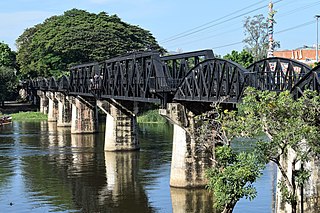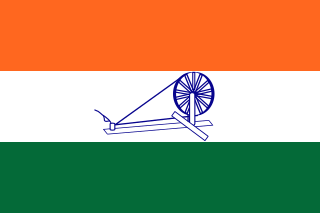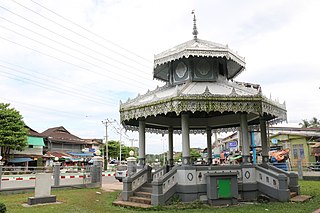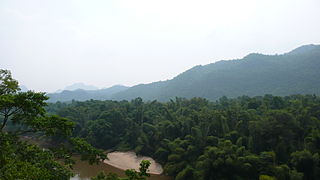
The Burma Railway, also known as the Siam–Burma Railway, Thai–Burma Railway and similar names, or as the Death Railway, is a 415 km (258 mi) railway between Ban Pong, Thailand, and Thanbyuzayat, Burma. It was built from 1940 to 1943 by South East Asian civilians abducted and forced to work by the Japanese and a smaller group of captured Allied soldiers, to supply troops and weapons in the Burma campaign of World War II. It completed the rail link between Bangkok, Thailand, and Rangoon, Burma. The name used by the Japanese Government was Tai–Men Rensetsu Tetsudō (泰緬連接鉄道), which means Thailand-Burma-Link-Railway.

The Indian National Army was a collaborationist armed unit of Indian collaborators that fought under the command of the Japanese Empire. It was founded by Mohan Singh on 1 September 1942 in Southeast Asia during World War II.

Hellfire Pass is the name of a railway cutting on the former Burma Railway in Thailand which was built with forced labour during the Second World War. More than 250,000 Southeast Asian civilians and 12,000 Allied soldiers built the railway line, including Hellfire Pass. The pass is noted for the harsh conditions and heavy loss of life suffered by its labourers during construction. It was called Hellfire Pass because the sight of emaciated prisoners labouring by burning torchlight resembled a scene from Hell.

The Burma campaign was a series of battles fought in the British colony of Burma. It was part of the South-East Asian theatre of World War II and primarily involved forces of the Allies against the invading forces of the Empire of Japan. Imperial Japan was supported by the Thai Phayap Army, as well as two collaborationist independence movements and armies. Nominally independent puppet states were established in the conquered areas and some territories were annexed by Thailand. In 1942 and 1943, the international Allied force in British India launched several failed offensives to retake lost territories. Fighting intensified in 1944, and British Empire forces peaked at around 1 million land and air forces. These forces were drawn primarily from British India, with British Army forces, 100,000 East and West African colonial troops, and smaller numbers of land and air forces from several other Dominions and Colonies. These additional forces allowed the Allied recapture of Burma in 1945.

The JEATH War Museum are two war museums in Kanchanaburi, Thailand about the Death Railway, which was built from 1942 to 1943 by Allied POWs under the direction of the Japanese as part of the Thai-Burma railways. The older JEATH museum is located in the CBD area of Kanchanaburi, while the other is located near the Bridge over the River Kwai.

Sook Ching was a mass killing that occurred from 18 February to 4 March 1942 in Singapore after it fell to the Japanese. It was a systematic purge and massacre of 'anti-Japanese' elements in Singapore, with the Singaporean Chinese particularly targeted by the Japanese military during the occupation. However, Japanese soldiers engaged in indiscriminate killing, and did not try to identify who was 'anti-Japanese.'

The South-East Asian Theatre of World War II consisted of the campaigns of the Pacific War in the Philippines, Thailand, Indonesia, Indochina, Burma, India, Malaya and Singapore between 1941 and 1945.

Force 136 was a far eastern branch of the British World War II intelligence organisation, the Special Operations Executive (SOE). Originally set up in 1941 as the India Mission with the cover name of GSI(k), it absorbed what was left of SOE's Oriental Mission in April 1942. The man in overall charge for the duration of its existence was Colin Mackenzie.

The Bridge over the River Kwai is a novel by the French novelist Pierre Boulle, published in French in 1952 and English translation by Xan Fielding in 1954. The story is fictional but uses the construction of the Burma Railway, in 1942–1943, as its historical setting, and is partly based on Pierre Boulle's own life experience working in Malaysia rubber plantations and later working for allied forces in Singapore and French Indochina during World War II. The novel deals with the plight of World War II British prisoners of war forced by the Imperial Japanese Army to build a bridge for the "Death Railway", so named because of the large number of prisoners and conscripts who died during its construction. The novel won France's Prix Sainte-Beuve in 1952.

Malaya, then under British administration, was gradually occupied by Japanese forces between 8 December 1941 and the Allied surrender at Singapore on 15 February 1942. The Japanese remained in occupation until their surrender to the Allies in 1945. The first Japanese garrison in Malaya to lay down their arms was in Penang on 2 September 1945 aboard HMS Nelson.

Tamil Malaysians, also known as Malaysian Tamilar, are people of full or partial Tamil descent who were born in or immigrated to Malaysia from Tamil Nadu, India and the Tamil regions of north-east Sri Lanka. The majority of 1.8–2 million people 80% of the Malaysian Indian populations in Malaysia were from Indian Tamil ethnic groups from Tamil Nadu and Sri Lanka. The bulk of Tamil Malaysian migration began during the British Raj, when Britain facilitated the migration of Indian workers to work in plantations. There are, however, some established Tamil communities from before British colonialism.

Thanbyuzayat is a town in the Mon State of south-eastern Myanmar. It is the administrative center for Thanbyuzayat Township. Thanbyuzayat is about 64 kilometres (40 mi) south of Mawlamyine (Moulmein) and 24 kilometres (15 mi) south-east of Kyaikkami (Amherst) and Setse beach.
Rail transport in Myanmar began in 1877. Three private rail companies were nationalised nineteen years later. During the Japanese occupation of Burma, Allied prisoners of war were forced to build the Burma Railway. Myanmar Railways has expanded its network somewhat since 1988.

Foreign relations exist between Australia and Thailand. Thailand is represented through its embassy in Canberra and a consulate general in Sydney. Australia has an embassy in Bangkok. Formal diplomatic relations were established between the two nations in 1952.

The Tenasserim Hills or Tenasserim Range is the geographical name of a roughly 1,700 km long mountain chain, part of the Indo-Malayan mountain system in Southeast Asia.
Takashi Nagase was a Japanese military interpreter during World War II. He worked for the Kempeitai at the construction of the Burma Railway in Thailand, and spent most of his later life as an activist for post-war reconciliation and against Japanese militarism. He made over a hundred visits to Thailand, and from the 1970s, arranged several meetings between former Allied prisoners of wars and their Japanese captors, in efforts to promote peace and understanding. In 1993, he met and reconciled with British former POW Eric Lomax—in whose torture sessions Nagase had been involved—an encounter retold in Lomax's 1995 autobiography The Railway Man.

The Thanbyuzayat War Cemetery is a prisoner of war cemetery for victims of Japanese imprisonment who died building the Death Railway in Burma. It is at the Burmese end of the Second World War railway construction, in Thanbyuzayat, 65 kilometres south of Mawlamyine (Moulmein). Thanbyuzayat is considered the terminus of the Death Railway, and is where it connected with the Burmese main line.

Nong Pladuk Junction railway station is a railway station in Nong Kop Sub-district, Ban Pong District, Ratchaburi. It is a class 3 railway station and is 64 km (39.8 mi) from Thon Buri railway station. It is on the Southern Line, and is the junction of two minor branch lines, the Nam Tok Line and Suphan Buri Line.

Konkoita is a former prisoner of war camp in the Sangkhla Buri District of the Kanchanaburi Province, Thailand. Located near the Karen village of Ban Kroeng Kruai, it was the location where the two sides of the Burma Railway met on 17 October 1943 at 262.87 kilometres from the starting point in Thailand. Konkoita and neighbouring villages were flooded in June 1984 by the construction of the Vajiralongkorn Dam. The population in the area was resettled several kilometres from the original villages.
Henri Hekking (1902/03–1994) was a Dutch medical officer with the Royal Netherlands East Indies Army (KNIL) noted for his service in Japanese prisoner-of-war camps during the Second World War.























